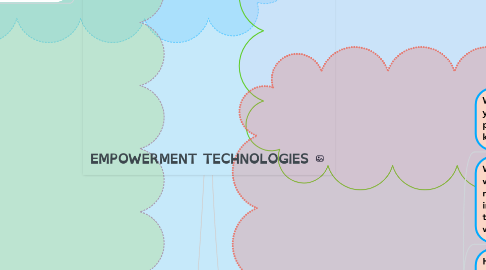EMPOWERMENT TECHNOLOGIES
by Yishin Vallejera Ibo


1. Lesson 9: Collaborative ICT Development
1.1. WEB PORTALS- is a website that contains information from different sources and places them in ne location in a uniform way.
1.2. They are plenty of online collaborative tools:
1.3. 1. you can use facebook groups to create a group page that will allow people in your group to communiate your ideas.
1.4. 2. wordpress also allows you to multiple contributors for a single blog.
1.5. 3. Google drive and microsoft office online allow multiple people to work on different office files.
1.6. 4. Sites like trello offer an online to-do checklist for your entire team.
1.7. TRELLO- a free tool used for online collaboration.
1.8. YAMMER- another free tool that can be used for online collaboration.
2. Lesson 10: Interactive multimedia
2.1. There was time that the internet was not as fast as today's internet that only text, images, and bits of sounds are placed on most websites.
2.2. 1, VIDEOS- through video hosting sites, you can take a video and show it to the entire world. e.g youtube
2.3. MULTIMEDIA CONTENT
2.4. 2. SOUND, MUSIC, OR AUDIO- if videos are too much for you , you can always record sounds. e.g soundcloud
2.5. 3. ONLINE GAMES- game developers now create what is called 'browser-based games'. you do not need to install these games to your computer as they run in most updated web browser e.g Adventurequest, farmville, candycrush.
2.6. 4. ONLINE TESTS- online survey forms and tests that automatically display the results when finished e.g online IQ and personality tests.
2.7. 5. COURSEWARE- online courses that stimulate the classroom online e.g E-learning courses using a learning management system.
2.8. 6. PODCASTS- an episodic series of audio or text files streamed online e.g Stuff you should know, TED talks etc.
2.9. 7. VODCASTS- an episodic series of video streamed online e.g Youtube series, Good mythical morning.
2.10. Key terms: EMBED- to place an object from one sie to another.
2.11. MULTIMEDIA- Uses multiple media contents like videos, sounds, applications etc.
3. Lesson 7: Online Platforms for ICT Content Development.
3.1. blogging platforms- website like wordpress, and tumblr focus on content and design.
3.2. social media platforms - allow you to create not only personal accounts but also pages where you can share content.
3.3. Content management system (CMS) - a computer application that allows you to publish, edit and manipulate.
3.4. Cloud computing (advantage )
3.4.1. 1. no need to install. 2. saves hard disk space 3. Easy access to software. 4. saves you money 5. no need to update. 6. Minimum system req. 7. back up and data recovery easier.
3.5. Cloud computing (disadvantages)
3.5.1. 1. hampered down by slow internet 2. require compatible software 3. you do not own the software 4. security risk 5. prone to hacking 6. limited control.
